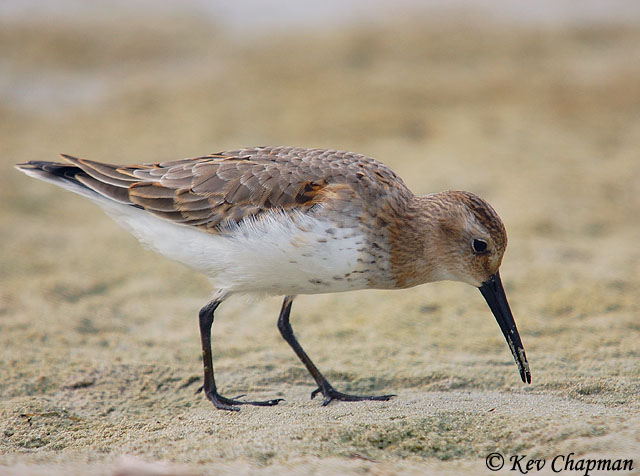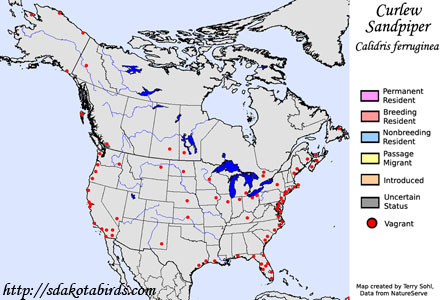| Length: 8.5 inches | Wingspan: 18 inches | Seasonality: Non-resident in South Dakota |
| ID Keys: Long drooped black bill, light supercillium, grayish above and white below in non-breeding plumage, rich rufous on breast and back of adult breeding males, breeding females similar but duller. | ||
 The
Curlew Sandpiper is primarily a bird of the Old World, breeding in Siberia,
and wintering in southeast Asia or Australia. In North America, they
are mostly rare visitors, with individual birds sighted in many locations
across the continent, both along the coast, and in the interior of the
continent. They have nested occasionally in Alaska, but not
consistently, and only in very small numbers.
The
Curlew Sandpiper is primarily a bird of the Old World, breeding in Siberia,
and wintering in southeast Asia or Australia. In North America, they
are mostly rare visitors, with individual birds sighted in many locations
across the continent, both along the coast, and in the interior of the
continent. They have nested occasionally in Alaska, but not
consistently, and only in very small numbers.
Habitat: Found on damp tundra areas during the summer breeding season. In migration and in winter, they are found on mudflats and beaches.
Diet: Feeds mostly on insects in the breeding season, but will also feed on mollusks, small crustaceans, marine worms, and occasionally on seeds.
Behavior: Forages by walking in shallow water, using its bill to probe in the bottom mud. They will also pick items directly off the water's surface or the ground with their bill.
Nesting: The nest of a Curlew Sandpiper is a shallow depression on the ground, lined with mosses, lichens, and leaves. The female usually lays 4 eggs, and she alone incubates them. When the eggs hatch, the young quickly leave the nest and feed themselves. The female will stay with them and protect them until they fledge.
Song: Flight call of a Curlew Sandpiper is a soft churrup.
Migration: Birds mostly breed in Siberia, and migrate to Southeast Asia, or the Australian region, for the winter.
Interactive eBird Map: Click here to access an interactive eBird map of Curlew Sandpiper sightings
Similar Species: Closest in overall appearance is the Dunlin. Could also possibly be confused with the Red Knot.
Conservation Status: Populations large and may be increasing, and they are spread over a relatively wide geographic area. The IUCN lists the Curlew Sandpiper as a species of "Least Concern".
Further Information: 1) BirdLife International - Curlew Sandpiper
2) Birdweb.org - Curlew Sandpiper
3) WhatBird - Curlew Sandpiper
Photo Information: Photo taken by Kev Chapman - Photo licensed under Creative Commons Attribution 2.0 Generic License.
| Click below for a higher-resolution map |
 |
| South Dakota Status: Non-resident in South Dakota |
Additional Curlew Sandpiper Photos (coming soon!!)
